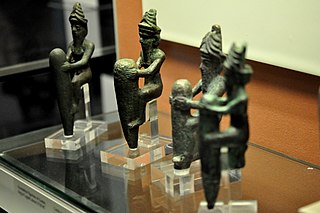
The Yukaghir, or Yukagir are a people in Russian Far East, living in the basin of the Kolyma River.

The pons is part of the brainstem, and in humans and other bipeds lies inferior to the midbrain, superior to the medulla oblongata and anterior to the cerebellum.

The brainstem is the posterior part of the brain, continuous with the spinal cord. In the human brain the brainstem includes the midbrain, and the pons and medulla oblongata of the hindbrain. Sometimes the diencephalon, the caudal part of the forebrain, is included.
Paleosiberianlanguages or Paleoasian (Paleo-Asiatic) are terms of convenience used in linguistics to classify a disparate group of linguistic isolates as well as a few small families of languages spoken in parts both of northeastern Siberia and of the Russian Far East. They are not known to have any linguistic relationship to each other; their only common link is that they are held to have antedated the more dominant languages, particularly Tungusic and latterly Turkic languages, that have largely displaced them. Even more recently, Turkic and especially Tungusic, have been displaced in their turn by Russian.

The Anunnaki are a group of deities that appear in the mythological traditions of the ancient Sumerians, Akkadians, Assyrians, and Babylonians. Descriptions of how many Anunnaki there were and what role they fulfilled are inconsistent and often contradictory. In the earliest Sumerian writings about them, which come from the Post-Akkadian period, the Anunnaki are the most powerful deities in the pantheon, descendants of An, the god of the heavens, and their primary function is to decree the fates of humanity.

The Yukaghir languages are a small family of two closely related languages—Tundra and Kolyma Yukaghir—spoken by the Yukaghir in the Russian Far East living in the basin of the Kolyma River. At the 2002 Russian census, both Yukaghir languages taken together had 604 speakers. Recent reports from the field reveal that this number is far too high: Southern Yukaghir had maximum 5 fluent speakers in 2009, while the Tundra Yukaghir language had around 60-70. The entire family is thus to be regarded as moribund.

In ancient Greek religion and mythology, the twelve Olympians are the major deities of the Greek pantheon, commonly considered to be Zeus, Hera, Poseidon, Demeter, Athena, Apollo, Artemis, Ares, Aphrodite, Hephaestus, Hermes, and either Hestia or Dionysus. They were called 'Olympians' because, according to tradition, they resided on Mount Olympus.

Alice Joséphine Pons, known professionally as Lily Pons, was a French-American operatic soprano and actress who had an active career from the late 1920s through the early 1970s. As an opera singer she specialized in the coloratura soprano repertoire and was particularly associated with the title roles in Lakmé and Lucia di Lammermoor. In addition to appearing as a guest artist with many opera houses internationally, Pons enjoyed a long association with the Metropolitan Opera in New York City, where she performed nearly 300 times between 1931 and 1960.
Solar Pons is a fictional detective created by August Derleth as a pastiche of Arthur Conan Doyle's Sherlock Holmes.
Pugu is the sun god of the Yukaghir of Siberia. Like many other solar gods, he was also seen as a god of justice and law. He is revered as the defender of the oppressed and the punisher of evil deeds. He kills evil demons with his sun-flail in hopes of bringing peace to his land.
Ancient Semitic religion encompasses the polytheistic religions of the Semitic peoples from the ancient Near East and Northeast Africa. Since the term Semitic itself represents a rough category when referring to cultures, as opposed to languages, the definitive bounds of the term "ancient Semitic religion" are only approximate.
The Tundra Yukaghir language is one of only two extant Yukaghir languages. Last spoken in the tundra belt extending between the lower Indigirka to the lower Kolyma basin, Tundra Yukaghir was formerly spoken in a much wider area extending west to the Lena basin.

Uralic–Yukaghir, also known as Uralo-Yukaghir, is a proposed language family composed of Uralic and Yukaghir.

7P/Pons–Winnecke is a periodic Jupiter-family comet in the solar system.

Pons Aelius, or Newcastle Roman Fort, was an auxiliary castra and small Roman settlement on Hadrian's Wall in the Roman province of Britannia Inferior, situated on the north bank of the River Tyne close to the centre of present-day Newcastle upon Tyne, and occupied between the 2nd and 4th centuries AD.

Ancient Egyptian deities are the gods and goddesses worshipped in ancient Egypt. The beliefs and rituals surrounding these gods formed the core of ancient Egyptian religion, which emerged sometime in prehistory. Deities represented natural forces and phenomena, and the Egyptians supported and appeased them through offerings and rituals so that these forces would continue to function according to maat, or divine order. After the founding of the Egyptian state around 3100 BC, the authority to perform these tasks was controlled by the pharaoh, who claimed to be the gods' representative and managed the temples where the rituals were carried out.

Including the Russian Far East, the population of Siberia numbers just above 40 million people. As a result of the 17th to 19th century Russian conquest of Siberia and the subsequent population movements during the Soviet era, the demographics of Siberia today is dominated by native speakers of Russian. There remain a considerable number of indigenous groups, between them accounting for below 10% of total Siberian population, which are also genetically related to indigenous peoples of the Americas.
The Southern, Kolyma or Forest Yukaghir language is one of only two extant Yukaghir languages.

Circumpolar peoples and Arctic peoples are umbrella terms for the various indigenous peoples of the Arctic.













